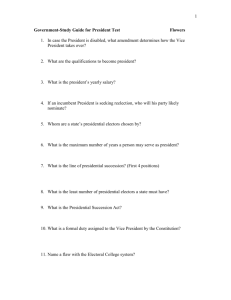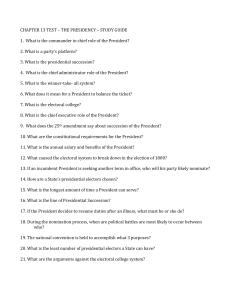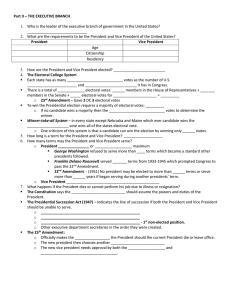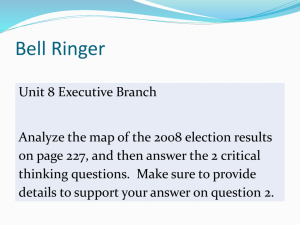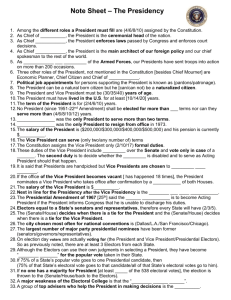Chapter 7 Section 1 The President and Vice President
advertisement
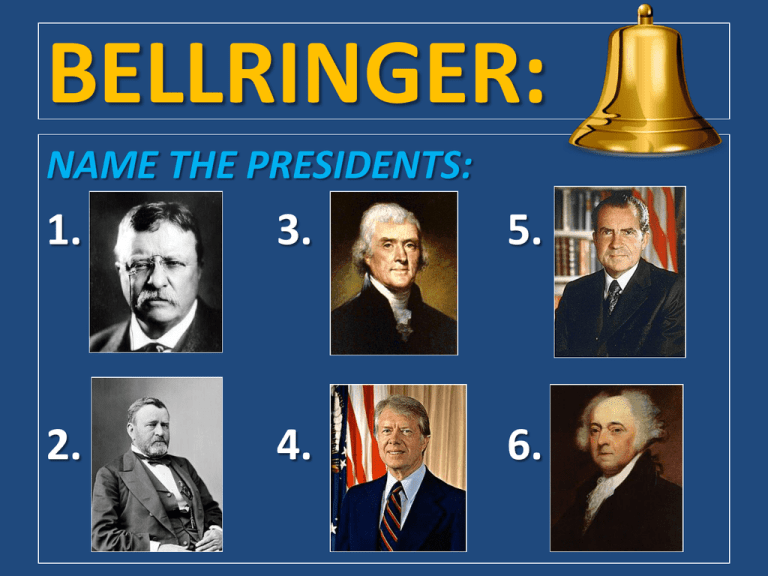
BELLRINGER: NAME THE PRESIDENTS: 1. 3. 5. 2. 4. 6. Chapter 7 / Section 1: The President and Vice President PRESIDENTIAL FACTS: • DID YOU KNOW? The election of John F. Kennedy was dramatic evidence that the presidency was changing. He was not only the first Catholic but also the youngest person to be elected president. In his Inaugural Address, Kennedy declared that leadership had passed “to a new generation of Americans.” He challenged Americans to be active citizens: “Ask not what your country can do for you-ask what you can do for your country.” GROUP WORK: • YOU AND A PARTNER LIST PERSONAL TRAITS YOU CONSIDER A PRESIDENTAL CANDIDATE SHOULD HAVE. 1. 2. 9. 10. 3. 4. 5. 11. 12. 6. 7. 8. U.S. CONSTITUTION • ARTICLE II of the United States Constitution creates the EXECUTIVE BRANCH of the government, consisting of the President, the Vice President, and other executive officers chosen by the President. I. Qualifications for President • A. The president heads the EXECUTIVE BRANCH – the top political job in the country and possibly the world. George Washington was the first to hold the office. • B. To become president, a person must be: (1) at least 35, (2) a native-born American citizen, and (3) a resident of the United States for at least 14 years. WHAT IS THIS FAMOUS MONUMENT? CAN YOU NAME THE PRESIDENTS FEATURED? • C. So far, every U.S. president has been a male. All but one has been Protestant Christian. Most have had a college education. Many were lawyers. Most came from states with large populations. HOW IMPORTANT ARE A CANDIDATES RELIGIOUS BELIEFS? SHOULD IT MATTER? QUESTION & ANSWER DISCUSSION QUESTION: • The president of the United States is generally considered to hold the most important job in the world. Why? ANSWER: • The job of the U.S. president is generally considered the most important in the world because of the power and global influence of the United States. II. Electing a President • A. Presidential elections take place every four years in years evenly divisible by 4. • B. The Constitution set up an indirect method of election called the Electoral College. By marking their ballots for a particular candidate, voters are actually selecting their state’s electors. The electors are pledged to vote for the chosen candidate. • C. Each state has as many electoral votes as the total of its members in Congress. This means that states with larger populations have more electoral votes. • D. In almost all states, the winning candidate receives all the electoral votes, even if the person wins by only a small majority. As a result, candidates focus their campaigns on states with the most electoral votes. It takes 270 of the 538 electoral votes to win. • E. The media announces the winner the evening of the election. However, the outcome is not official until the Electoral College casts ballots and Congress counts them. HOW MANY PRESIDENTIAL ELECTORAL COLLEGE VOTES DOES ALABAMA HAVE? QUESTION & ANSWER DISCUSSION QUESTION: • Your ballot for president will show the names of all the candidates. When you select one, are you voting directly for that person? Explain. ANSWER: • No. When you vote for a candidate, you are actually voting for a list of presidential electors pledged to that candidate. III. Term of Office • A. Presidents serve four-year terms. The Twenty-second Amendment limits each president to two elected terms, or a maximum of 10 years if the president took office during another president’s term. PRESIDENTIAL FACTS: • Franklin Delano Roosevelt is the only president elected to 4 consecutive terms. • He was also paralyzed by a childhood illness known as polio. • B. The president receives a yearly salary of $400,000, plus expenses. The president lives and works at the White House. A staff tends to the needs of the president’s family. • C. Camp David, a beautiful estate in Maryland, serves as the president’s retreat and a place to host foreign leaders. Presidents travel in special cars, helicopters, and airplanes, such as Air Force One. QUESTION & ANSWER DISCUSSION QUESTION: • Before the Twenty-second Amendment, did most presidents serve more than two terms? Explain. ANSWER: • No. Originally the Constitution placed no limits on how many terms a president could serve. George Washington, however, chose to serve only two terms. All other presidents except one followed Washington’s example. DO YOU REMEMBER WHO THAT WAS? IV. The Vice President • A. The VICE PRESIDENT is elected with the president, and the qualifications are the same for both jobs. • B. The vice president votes in the Senate in case of a tie, but otherwise has little authority. Yet if the president dies, is removed from office, becomes seriously ill, or resigns, the vice president becomes president. QUESTION & ANSWER DISCUSSION QUESTION: • A vice president’s activities rarely make headlines. Under what circumstances would a vice president suddenly become the focus of attention? ANSWER: • The rarely visible vice president would suddenly become the focus of attention if the president became ill, died, or left office. The vice president would then become president. PRESIDENTIAL FACTS: • At 12:30 pm Central Standard Time on November 22, John F. Kennedy was assassinated in Dallas, Texas while riding with his wife, Jacqueline, in the presidential motorcade. Johnson was riding in a car behind the president with his wife, Lady Bird Johnson, and Texas Senator Ralph Yarborough. • Johnson was sworn in to office aboard the presidential plane AIR FORCE ONE. V. Presidential Succession • A. The Constitution was not clear about whether the vice president would become president or just take over the president’s duties if the president could no longer serve. Vice President John Tyler settled the question. He took the oath as president when William Henry Harrison died in office. • B. The Presidential Succession Act of 1947 established the line of succession. If both the president and Vice President die or leave office, the Speaker of the House would be next, followed by the President pro tempore, and then the Secretary of State. • C. Later the Twenty-fifth Amendment further established that the vice president, after becoming president, would choose another vice president. Both houses of Congress must approve the choice. • D. The amendment gives the vice president a role in determining whether a president is disabled and unable to do the job. The vice president would then act as president until the president is able to go back to work. CHECK YOUR NOTES… ACCORDING TO WHAT YOU’VE LEARNED, WHO SUCCEEDS THE PRESIDENT ACCORDING TO THE PRESIDENTIAL SUCCESSION ACT OF 1947? 1. 2. 3. 4. 5. QUESTION & ANSWER DISCUSSION QUESTION: • If both the president and vice president die or leave office, who would be the next three people in the order of presidential succession? ANSWER: • The next three would be the Speaker of the House John Boehner, followed by the President pro tempore Daniel Inouye of the Senate, and then the Secretary of State Hilary Clinton. EXIT STRATEGY: TRACE THE STEPS TO BECOME THE PRESIDENT…

